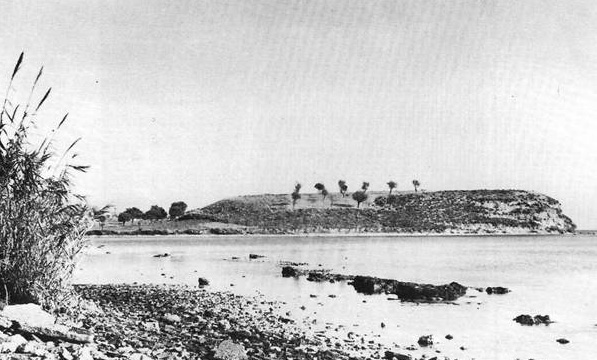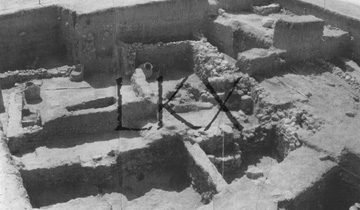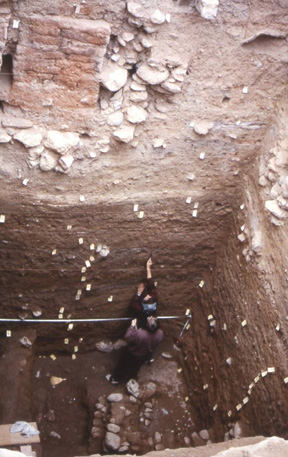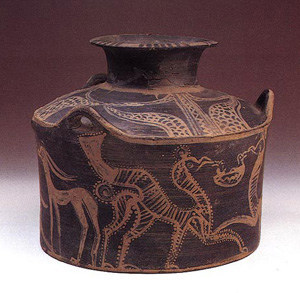
EARLY EXCAVATIONS OF THE SETTLEMENT
Xeropolis is a long narrow plateau, rising some 17 m above the sea and with a gentle incline on the landward side. It is a large site, some 500 meters in length and 120 meters broad. Visitors are always surprised of the great size of Xeropolis which has remained uninhabited since the end of the eight century BC. In antiquity the site was extensively occupied from the Early Bronze Age (roughly around 2100 BC) to the end of the Geometric period (around 700 BC). Xeropolis has small bays on either side and is situated close to the renowned Lelantine plain where one of the earliest recorded conflicts took place between the ancient towns of Chalkis and Eretria. The plain even today is one of the most fertile regions in Euboea.
 |
The ancient name of the site, however, has not been preserved. Scholars suggest various names, most of them associated with Homeric towns in Euboea such as Oechalia, and Kerinthos. Mervyn Popham, however, put forward the name Lelanton; he based his arguments on a number of ancient sources which indicate that the famous war was ‘about Lelanton’. Thus he ingeniously suggested that Lelanton was the name of the site rather than of the plain. Other scholars, however, prefer to see Xeropolis as ‘old Chalcis’ or following Strabo ‘old Eretria’.
 |
Late
Helladic IIIC (Phase 1b) rooms |
The first excavation at Lefkandi took place on Xeropolis in 1964 under the direction of Mervyn Popham and Hugh Sackett. The small area excavated by the early team, revealed that the site was continuously occupied from the Early Bronze Age to the end of the Geometric period. A deep sounding which reached to the bed-rock exposed the earliest buildings which had pottery dated to the Early Bronze Age. Above this early settlement, five layers with typical Middle Helladic (Middle Bronze Age) pottery and finds were exposed. The deep accumulation of Middle Helladic deposits demonstrates the importance of Xeropolis during this period. Moreover, in a trial – near the north-west edge of the tell – there is evidence of a fortification wall which was most probably built in the Middle Helladic period. The Late Bronze Age history of the site is also notable. The present archaeological picture suggests that during the period of the Mycenaean palaces Xeropolis was not as perhaps important as other sites on the island. In the small area which was excavated at the time, the Late Helladic I–IIIA material is not extensive, nor is that found in the Late Helladic IIIB levels. This might be accidental or it could reflect the deliberate terracing and leveling which was carried out for the construction of the Late Helladic IIIC houses.
 |
| Deep
sounding in Trench CC |
It is indeed the Late Helladic IIIC period (roughly from the beginning of the twelfth to the middle of the eleventh centuries BC) which is well represented on the site. Evidence from the excavated area reveals three stages of occupation - Phases 1, 2 and, 3 - which were subsequently subdivided into 1a, 1b, 2a, 2b and 3, based on the pottery associated with the levels of occupation. The agricultural wealth of the community was reflected in the discovery of storage pithoi containing remains of olives and barley. At the end of Phase 1, a major destruction affected the site but the settlement was soon rebuilt; this time, however, with much more careful planning. The rooms of the houses are also more spacious and built with stone socles and mud-bricks. An interesting practice during this phase is the appearance of intra-mural burials found close to the walls of the houses.
The most impressive find associated with Phase 2 on Xeropolis is the discovery of some fine examples of the so-called Pictorial pottery. Vases with pictorial decoration – also found in a number of other sites in the Aegean – indicate a revival of representational art during this post-palatial period.
 |
| LH
IIIC Alabastron with Pictorial Scene |
There is only limited evidence from the last stage of the Late Helladic IIIC (Phase 3). At the time it was believed that this was a period of decline which might have ended in a short abandonment of the site. The more recent excavations, however, appear to contradict such a picture.
The next period of use in the area excavated by the first team was the Late Protogeometric (end of the tenth century BC) and a number of rubbish pits from this period were found. Among the finds the most impressive was the discovery of clay moulds for casting bronze tripod legs, revealing sophisticated knowledge in the production of bronze objects.
A large, most probably apsidal, building was also excavated; it is dated to the end of the Geometric period (eighth century BC). Near the house were also found three circular structures built against a long wall. Their structure suggests that they might have been granaries. Among the pottery fragments dated to this period, a number bear fragmentary inscriptions of personal names. These graffiti show typical characteristics of the early Euboic script.
Home > History of Research>Early Excavations of the Settlement> The Cemeteries